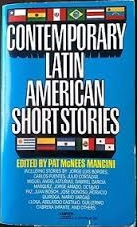I've had this copy of Contemporary Latin American Short Stories edited by Pat McNees Mancini (1974) for so long that I have no idea where or when I got it, but, since it comes near the start of my bookshelf, it was next on my quest to read all the books I own and haven't read yet.
This collection of 35 stories by Latin American authors may stretch the definition of "contemporary" a bit, since some of the stories were published in the early 20th century, but in the contemporary context of 1974, most of these authors and their works would have been unknown to an English-speaking audience. The collection includes some heavy hitters (Jorge Luis Borges, Octavio Paz, Gabríel Garcia Márquez, Mario Varga Llosa) as well as many authors that were unfamiliar to me, from all over Latin America.
Each story includes a one page introduction with some biographical information about the author and their work. I would have liked more consistency in noting when the story included in the collection was written, but Mancini generally does a good job of putting the stories in context. Having biographical sketches of dozens of Latin American authors in 1974 really highlights the political nature of art in the region, with the many of the authors being exiled, becoming part of their country's leadership, or both. Only two women are included, which doesn't come as a huge surprise, but does date the collection.
The stories themselves are really strong -- ranging in length from just a few pages to entire novellas, they include magical realism, formal structure, humor, tragedy, and political metaphors. Some particular favorites of mine were the extremely weird "Letter to a Young Lady in Paris," by Julio Cortázar (so many bunnies!); the brooding and atmospheric "The Doll Queen," by Carlos Fuentes; "Nest, Door, Neighbors," by Guillermo Cabrera Infante (with the added bonus of being translated by the author, which brings in some excellent effects), and "Paseo," by José Donoso, which I still can't get out of my head.
For fans of both Latin American literature and the short story as an art form, this is a great read. Highly recommended.
Sunday, August 21, 2016
Sunday, August 07, 2016
How to Manage Processing in Archives and Special Collections by Pam Hackbart-Dean and Elizabeth Slomba (2012)
This work-related book, How to Manage Processing in Archives and Special Collections by Pam Hackbart-Dean and Elizabeth Slomba (2012), is a great overview of all the different things you have to do manage the processing process in an archives. Plus, I checked it out from my library -- oh yeah!
Hackbart-Dean and Slomba lead us through creating a processing program, setting processing priorities (I loved this part -- matrices!), managing processing, preservation administration, description and standards, training and managing staff, and evaluation and assessment. Whew. If that sounds comprehensive, well, it is. It also bleeds a lot into general archives management, which is a big strength of the book. Processing is such a huge part of archival administration, that you can't really talk about managing it without talking about managing the whole thing.
I appreciated that this is a slim volume with relatively short chapters. That necessarily means that some things are gone over quickly and not every possible topic is covered at length. The authors make up for that by providing extensive footnotes and a really helpful annotated bibliography at the end. My one criticism would be the very short amount of time that is given to electronic records. While they are mentioned a few times, and some suggestions for further reading are given, I think the book would have been strengthened by a chapter dedicated to the unique challenges of managing the processing of digital archives.
This is a good review book for mid-career professionals like me. It helped me to put some perspective on my day-to-day work and to step back and reevaluate the way I do some things. Not every suggestion would work for a one-woman shop like mine, but there is enough here for any archivist to really sink their teeth into. Nice work!
Hackbart-Dean and Slomba lead us through creating a processing program, setting processing priorities (I loved this part -- matrices!), managing processing, preservation administration, description and standards, training and managing staff, and evaluation and assessment. Whew. If that sounds comprehensive, well, it is. It also bleeds a lot into general archives management, which is a big strength of the book. Processing is such a huge part of archival administration, that you can't really talk about managing it without talking about managing the whole thing.
I appreciated that this is a slim volume with relatively short chapters. That necessarily means that some things are gone over quickly and not every possible topic is covered at length. The authors make up for that by providing extensive footnotes and a really helpful annotated bibliography at the end. My one criticism would be the very short amount of time that is given to electronic records. While they are mentioned a few times, and some suggestions for further reading are given, I think the book would have been strengthened by a chapter dedicated to the unique challenges of managing the processing of digital archives.
This is a good review book for mid-career professionals like me. It helped me to put some perspective on my day-to-day work and to step back and reevaluate the way I do some things. Not every suggestion would work for a one-woman shop like mine, but there is enough here for any archivist to really sink their teeth into. Nice work!
Subscribe to:
Posts (Atom)

